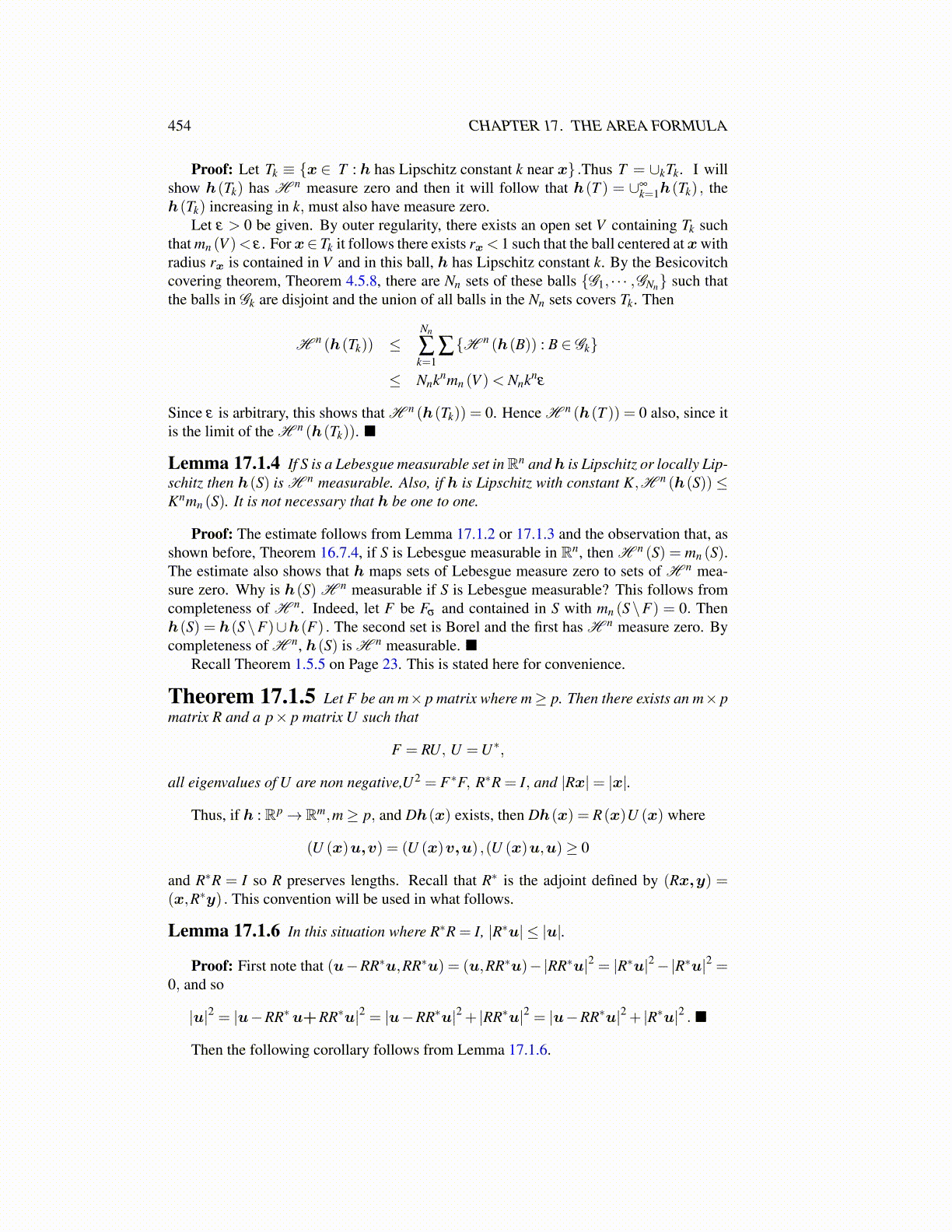
454 CHAPTER 17. THE AREA FORMULA
Proof: Let Tk ≡ {x ∈ T : h has Lipschitz constant k near x} .Thus T = ∪kTk. I willshow h(Tk) has H n measure zero and then it will follow that h(T ) = ∪∞
k=1h(Tk) , theh(Tk) increasing in k, must also have measure zero.
Let ε > 0 be given. By outer regularity, there exists an open set V containing Tk suchthat mn (V )< ε . Forx∈ Tk it follows there exists rx < 1 such that the ball centered atxwithradius rx is contained in V and in this ball, h has Lipschitz constant k. By the Besicovitchcovering theorem, Theorem 4.5.8, there are Nn sets of these balls {G1, · · · ,GNn} such thatthe balls in Gk are disjoint and the union of all balls in the Nn sets covers Tk. Then
H n (h(Tk)) ≤Nn
∑k=1
∑{H n (h(B)) : B ∈ Gk}
≤ Nnknmn (V )< Nnknε
Since ε is arbitrary, this shows that H n (h(Tk)) = 0. Hence H n (h(T )) = 0 also, since itis the limit of the H n (h(Tk)). ■
Lemma 17.1.4 If S is a Lebesgue measurable set inRn andh is Lipschitz or locally Lip-schitz then h(S) is H n measurable. Also, if h is Lipschitz with constant K,H n (h(S))≤Knmn (S). It is not necessary that h be one to one.
Proof: The estimate follows from Lemma 17.1.2 or 17.1.3 and the observation that, asshown before, Theorem 16.7.4, if S is Lebesgue measurable in Rn, then H n (S) = mn (S).The estimate also shows that h maps sets of Lebesgue measure zero to sets of H n mea-sure zero. Why is h(S) H n measurable if S is Lebesgue measurable? This follows fromcompleteness of H n. Indeed, let F be Fσ and contained in S with mn (S\F) = 0. Thenh(S) = h(S\F)∪h(F) . The second set is Borel and the first has H n measure zero. Bycompleteness of H n, h(S) is H n measurable. ■
Recall Theorem 1.5.5 on Page 23. This is stated here for convenience.
Theorem 17.1.5 Let F be an m× p matrix where m≥ p. Then there exists an m× pmatrix R and a p× p matrix U such that
F = RU, U =U∗,
all eigenvalues of U are non negative,U2 = F∗F, R∗R = I, and |Rx|= |x|.
Thus, if h : Rp→ Rm,m≥ p, and Dh(x) exists, then Dh(x) = R(x)U (x) where
(U (x)u,v) = (U (x)v,u) ,(U (x)u,u)≥ 0
and R∗R = I so R preserves lengths. Recall that R∗ is the adjoint defined by (Rx,y) =(x,R∗y) . This convention will be used in what follows.
Lemma 17.1.6 In this situation where R∗R = I, |R∗u| ≤ |u|.
Proof: First note that (u−RR∗u,RR∗u) = (u,RR∗u)−|RR∗u|2 = |R∗u|2−|R∗u|2 =0, and so
|u|2 = |u−RR∗u+RR∗u|2 = |u−RR∗u|2 + |RR∗u|2 = |u−RR∗u|2 + |R∗u|2 . ■
Then the following corollary follows from Lemma 17.1.6.